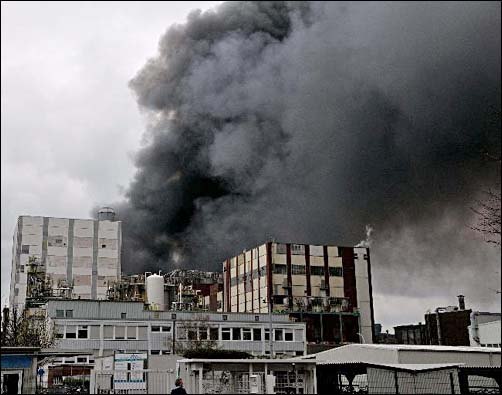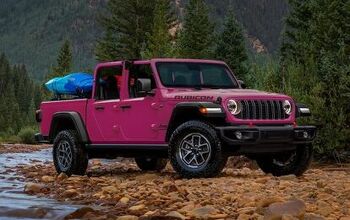Maker Of Strategic Material May Be Down For Months, Shortages To Last Longer

Evonik Industries told Reuters that it will take at least three months for its damaged chemical plant in Marl, Germany, to resume normal production of CDT, and that full production of CDT may not return until the beginning of next winter.
CDT is a base ingredient for the production of nylon resin PA-12. That resin is used as a coating on fuel and braking systems on most passenger cars worldwide. Evonik is the world’s leading maker of cyclododecatriene.
According to Automobile Magazine, the tight supply of Cyclododecatriene had been known for several years. Evonik was planning on adding capacity in Asia, but that factory won’t be ready until the end of 2014.
With several weeks of supply in the pipeline to U.S. and Asian makers, “disruptions will likely start in Europe,” said Rod Lache, an analyst for Deutsche Bank AG. Once stockpiles are used up, shortages are estimated to last about six to nine months.
Evonik is not the only manufacturer of CDT as some commenters noted, but is the world’s biggest. DuPont currently supplies Fiat with fuel lines made from its own specialty polymers that do not contain CDT. Evonik told Reuters that it is looking into alternative materials that can be used as a resin without CDT.
However, suppliers and especially materials cannot be switched at will. Neil De Koker, president of the Original Equipment Suppliers Association told Bloomberg:
“Brake lines and fuel lines are safety products, so you don’t make changes overnight. You have to do them very carefully with the right testing to prove out the product.”
Testing and certification of safety products such as fuel and brake lines can take many months. This is a process the industry does not want to rush. When Renesas, a supplier of chips for on-board electronics, had a fab wiped out by the tsunami, automakers found themselves in a similar situation. Renesas is not the only chipmaker. Chips can be changed. However re-engineering and re-certification of systems would have taken longer than simply waiting for the fab to resume production.

Bertel Schmitt comes back to journalism after taking a 35 year break in advertising and marketing. He ran and owned advertising agencies in Duesseldorf, Germany, and New York City. Volkswagen A.G. was Bertel's most important corporate account. Schmitt's advertising and marketing career touched many corners of the industry with a special focus on automotive products and services. Since 2004, he lives in Japan and China with his wife <a href="http://www.tomokoandbertel.com"> Tomoko </a>. Bertel Schmitt is a founding board member of the <a href="http://www.offshoresuperseries.com"> Offshore Super Series </a>, an American offshore powerboat racing organization. He is co-owner of the racing team Typhoon.
More by Bertel Schmitt
Latest Car Reviews
Read moreLatest Product Reviews
Read moreRecent Comments
- Master Baiter I thought we wanted high oil prices to reduce consumption, to save the planet from climate change. Make up your minds, Democrats.
- Teddyc73 Oh look dull grey with black wheels. How original.
- Teddyc73 "Matte paint looks good on this car." No it doesn't. It doesn't look good on any car. From the Nissan Versa I rented all the up to this monstrosity. This paint trend needs to die before out roads are awash with grey vehicles with black wheels. Why are people such lemmings lacking in individuality? Come on people, embrace color.
- Flashindapan Will I miss the Malibu, no. Will I miss one less midsize sedan that’s comfortable, reliable and reasonably priced, yes.
- Theflyersfan I used to love the 7-series. One of those aspirational luxury cars. And then I parked right next to one of the new ones just over the weekend. And that love went away. Honestly, if this is what the Chinese market thinks is luxury, let them have it. Because, and I'll be reserved here, this is one butt-ugly, mutha f'n, unholy trainwreck of a design. There has to be an excellent car under all of the grotesque and overdone bodywork. What were they thinking? Luxury is a feeling. It's the soft leather seats. It's the solid door thunk. It's groundbreaking engineering (that hopefully holds up.) It's a presence that oozes "I have arrived," not screaming "LOOK AT ME EVERYONE!!!" The latter is the yahoo who just won $1,000,000 off of a scratch-off and blows it on extra chrome and a dozen light bars on a new F150. It isn't six feet of screens, a dozen suspension settings that don't feel right, and no steering feel. It also isn't a design that is going to be so dated looking in five years that no one is going to want to touch it. Didn't BMW learn anything from the Bangle-butt backlash of 2002?


































Comments
Join the conversation
"Chips can be changed. However re-engineering and re-certification of systems would have taken longer than simply waiting for the fab to resume production." The time to qualify a second source is *before* the plant blows up, not after. I understand vendor partnership, but I'm surprised more companies don't seem to qualify second sources eliminate single points of failure in their supply chains.
Most major chemicals including industrial, fertilizers, pharmaceutical, vitamins, etc, are generally only manufactured in two or three major factories. That being said, cant fuel and brake lines be switched over to steel relatively easily?